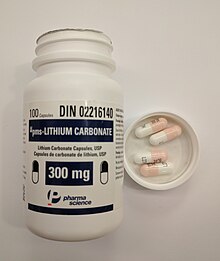
Back تسمم بالليثيوم Arabic Otrava lithiem Czech Intoxicación por litio Spanish مسمومیت با لیتیوم Persian Toxicité du lithium French リチウム毒性 Japanese ଲିଥିଅମ ବିଷକ୍ରିୟା OR Toksičnost litijuma Serbian Nhiễm độc lithi Vietnamese
| Lithium toxicity | |
|---|---|
| Other names | Lithium overdose, lithium poisoning |
 | |
| A bottle of lithium capsules | |
| Specialty | Toxicology |
| Symptoms | Tremor, increased reflexes, trouble walking, kidney problems, altered level of consciousness[1] |
| Complications | Serotonin syndrome, brain damage[1] |
| Types | Acute, chronic, acute on chronic[1] |
| Causes | Excessive intake, decreased excretion[1] |
| Risk factors | Dehydration, low sodium diet, kidney problems[1] |
| Diagnostic method | Based on symptoms and a lithium level[1][2] |
| Treatment | Gastric lavage, whole bowel irrigation, hemodialysis[1] |
| Prognosis | Low risk of death[3] |
Lithium toxicity, also known as lithium overdose, is the condition of having too much lithium. Symptoms may include a tremor, increased reflexes, trouble walking, kidney problems, and an altered level of consciousness. Some symptoms may last for a year after levels return to normal. Complications may include serotonin syndrome.[1]
Lithium toxicity can occur due to excessive intake or decreased excretion.[1] Excessive intake may be either a suicide attempt or accidental.[1] Decreased excretion may occur as a result of dehydration such as from vomiting or diarrhea, a low sodium diet, or from kidney problems.[1] The diagnosis is generally based on symptoms and supported by a lithium level in blood serum of greater than 1.2 mEq/L.[1][2]
Gastric lavage and whole bowel irrigation may be useful if done early.[1] Activated charcoal is not effective.[1] For severe toxicity hemodialysis is recommended.[1] The risk of death is generally low.[3] Acute toxicity generally has better outcomes than chronic toxicity.[4] In the United States about 5,000 cases are reported to poison control centers a year.[2] Lithium toxicity was first described in 1898.[1]
- ^ a b c d e f g h i j k l m n o p Hedya, Shireen A.; Avula, Akshay; Swoboda, Henry D. (2019). "Lithium Toxicity". StatPearls. StatPearls Publishing. PMID 29763168. Retrieved 22 December 2019.
- ^ a b c "Lithium Toxicity | California Poison Control System | UCSF". calpoison.org. Retrieved 22 December 2019.
- ^ a b Baird-Gunning, J; Lea-Henry, T; Hoegberg, LCG; Gosselin, S; Roberts, DM (May 2017). "Lithium Poisoning". Journal of Intensive Care Medicine. 32 (4): 249–263. doi:10.1177/0885066616651582. PMID 27516079. S2CID 22678221.
- ^ Waring, WS (2006). "Management of lithium toxicity". Toxicological Reviews. 25 (4): 221–30. doi:10.2165/00139709-200625040-00003. PMID 17288494. S2CID 22844004.